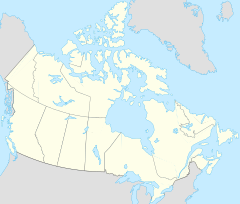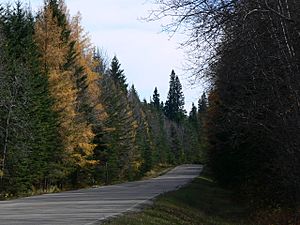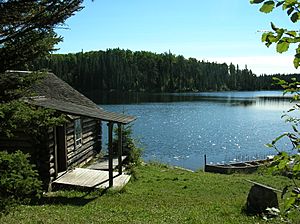Prince Albert National Park facts for kids
Quick facts for kids Prince Albert National Park |
|
|---|---|
|
IUCN Category II (National Park)
|
|
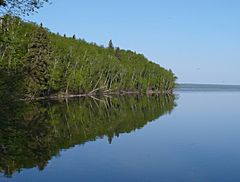
Lake Waskesiu in Prince Albert National Park
|
|
| Location | Saskatchewan, Canada |
| Nearest city | Prince Albert |
| Area | 3,874 km2 (1,496 sq mi) |
| Established | March 24, 1927 |
| Visitors | 258,613 (in 2015-16) |
| Governing body | Parks Canada |
Prince Albert National Park is a huge natural area in central Saskatchewan, Canada. It covers about 3,874 square kilometers (1,496 square miles). The park is located about 200 kilometers (124 miles) north of Saskatoon.
This park was officially opened on August 10, 1928, by the Prime Minister of Canada, William Lyon Mackenzie King. It is open all year round. However, most people visit between May and September. The main entrance to the park is about 80 kilometers (50 miles) north of Prince Albert.
The park's elevation changes from 488 meters (1,601 feet) on the west side to 724 meters (2,375 feet) on the east side.
The only town inside the park is Waskesiu Lake. It sits on the southern shore of the lake with the same name. Here you can find many services and facilities for visitors.
This Canadian park is also home to the cabin of Grey Owl. He was a famous naturalist and conservationist. His cabin is on Ajawaan Lake.
Contents
Nature and Wildlife
Prince Albert National Park is part of Canada's southern boreal forest region. It has rolling hills and is mostly covered in trees. The park is located where the water flows towards the North Saskatchewan River and the Churchill River.
The very southern part of the park has many aspen trees. You can also find shrubs like elderberry, honeysuckle, and rose. There are open areas with fescue grassland. These grasslands are very important because they are rare. Outside the park, most of these native grasslands have been lost.
The mix of aspen forest and grassland in the southwest is special. It supports a growing herd of over 400 plains bison. This is the only wild herd in Canada that lives in its original home. It also has all its natural predators, like timber wolves.
Most of the park is covered by coniferous forests. These forests have many jack pine and white spruce trees. You will see more of these trees as you go further north. Boreal woodland caribou sometimes visit the park. However, their main home is outside the park to the north. White-tailed deer, elk, and moose are common here. Wolves are also seen often.
The park has many lakes, including three very large ones: Waskesiu, Kingsmere, and Crean. The water is clean, and there are many fish. However, lake trout were almost fished out of Crean Lake a long time ago. They are still recovering their numbers. Common fish include Northern pike, walleye, suckers, and lake whitefish.
One of Canada's largest colonies of white pelicans lives on Lavallee Lake. This area is closed to visitors. Pelicans, loons, mergansers, ospreys, and bald eagles are common in summer. Otters are seen all year round. Winter is a great time to spot otters near open water on Waskesiu Lake.
Park Wildlife
The park is home to many animals. You might see elk, moose, red foxes, beavers, white-tailed deer, badgers, bison, river otters, red squirrels, black bears, coyotes, and timber wolves. A herd of plains bison roams the southern areas.
Many birds live in the park too. These include flycatchers, Tennessee warblers, double-crested cormorants, red-necked grebes, brown creepers, nuthatches, three-toed woodpeckers, bald eagles, osprey, great blue herons, and many types of ducks. The common loon is also a common sight.
There are 21 types of fish in the park's waters. Some examples are Iowa darters, yellow perch, brook stickleback, spottail shiner, cisco, northern pike, walleye, and lake trout. While most people visit in summer, winter is often the best time to see wildlife.
Park History
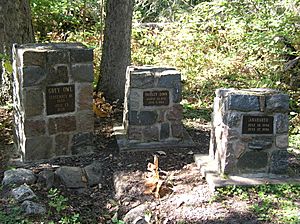
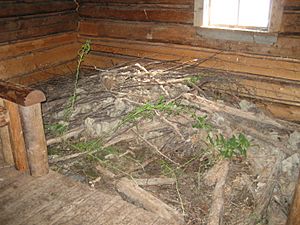
People have lived in this area for a very long time. Archeologists have found old tools in the park. These tools show that people were here thousands of years ago.
A Hudson's Bay Company fur trading post was located at Waskesiu Lake from 1886 to 1893.
In the early 1900s, fishing and logging were important industries here. However, a large forest fire in 1919 ended the logging industry.
Grey Owl's Legacy
Grey Owl, whose real name was Archibald Stanfield Belaney (1888-1938), was the park's first naturalist. He lived on Ajawaan Lake in Prince Albert National Park. He wrote several books about protecting the wilderness. These include Pilgrims of the Wild (1935) and Sajo and the Beaver People (1935). His life was even made into a movie called Grey Owl in 1999.
Fun Activities
There are many exciting things to do in Prince Albert National Park!
Driving Tours
You can explore the park by car on a few main roads:
- The Narrows Road goes along the southern shore of Waskesiu Lake. It has many nice spots for picnics.
- Lakeview Drive (Highway 263) takes you to other lakes like Namekus, Trappers, and Sandy. It also leads to many trails.
- Highway 264 goes to Kingsmere River. From here, you can launch a boat or canoe.
Picnic Spots
The park has many picnic areas. They have tables, beautiful views, and places for campfires. Some even have swimming areas.
- Namekus Lake
- Sandy Lake
- South Gate
- Meridian Day
- South Bay
- Trippes Beach
- King Island
- Paignton Beach
- The Narrows
- Waskesiu River
- Waskesiu Landing (Main Marina)
- Point View
- Birch Bay
- Heart Lakes
- Kingsmere
Hiking Adventures
There are many trails for walking and hiking. Some are short, about 3 kilometers (1.8 miles) or less. These trails often have brochures to help you learn about nature.
- Boundary Bog Trail
- Mud Creek Trail
- Treebeard Trail
- Waskesiu River Trail
- Kingsmere River Trail
- Red Deer Trail (Red, Blue, and Yellow loops)
- Ice-Push Ridge Trail
- Narrows Peninsula Trail
- Spruce River Highlands Tower Trail
For longer adventures, there are trails for backpackers. These range from 13 kilometers (8 miles) to 54 kilometers (33.5 miles) round trip.
- Kingfisher Trail
- Grey Owl Trail
- Fish Trail
- Hunters Trail
- Spruce River Highlands Trail
Swimming Spots
You can swim at several beaches around Waskesiu Lake during the warm summer months. There are also good beaches at the south end of Kingsmere Lake, Namekus Lake, and Sandy Lake.
Canoeing and Boating
The park has special canoe routes like the Bagwa Canoe Route and Bladebone Canoe Route. Many lakes are perfect for canoeing, such as Amiskowan, Shady, Heart, Kingsmere, and Waskesiu lakes.
Power boats are allowed on some lakes, including Waskesiu, Crean, Kingsmere, Sandy, and the Hanging Heart Lakes. There's a limit of 40 horsepower motors on Kingsmere Lake. You can rent boats, canoes, and kayaks at the Waskesiu Marina, Heart Lakes Marina, and The Narrows.
Fishing Fun
You can enjoy fishing for northern pike, walleye, lake trout, whitefish, or yellow perch. The park requires its own fishing license. Rules for fishing limits and seasons are different from the rest of Saskatchewan. Some areas are closed to fishing to protect fish.
Camping Options
You can choose between "front country" camping, which has more services, or "back country" camping, which is more rugged. Front country sites can be reserved online or by phone. Back country camping is popular on Kingsmere and Crean lakes. You need permits and pay fees for all camping.
Open fires are allowed at most campsites if you have a fire permit.
Here are some places where you can camp with your car, trailer, or motorhome:
- Beaver Glen Campground: Near Waskesiu town site. Some sites have electricity. It has washrooms with hot water and showers.
- Red Deer Campground: Also in Waskesiu town site. It has power, water, and sewage hookups at each site. No open fires are allowed here.
- The Narrows Campground: Has flush toilets with cold water.
- Namekus, Trappers, Sandy Lakes: These sites have septic tank toilets and water (not safe to drink without treatment).
There are also campsites you can reach by boat. Be careful, as waves on the lakes can get big with weather changes.
Learning Programs
The nature center in Waskesiu town site has information about special learning programs. These programs help you learn about the park's nature and history.
Wildlife Watching
The park is a great place to watch animals and birds. You might see elk, black bears, foxes, moose, beavers, deer, and otters. Many bird species live here, including bald eagles, ospreys, and common loons.
Even though most people visit in summer, winter is often the best time to see wildlife. Wolves often travel on the frozen lakes. Elk and deer are common right in the town of Waskesiu. You can often see otters near open water on Waskesiu Lake. Foxes are also frequently seen in winter.
Aurora Watching
Because the park is so far north, you can often see the Northern Lights (Auroras) on clear nights. This is true even when solar activity is not very high.
Golfing
The park has an 18-hole golf course called the Waskesiu Golf Course. It was designed by Stanley Thompson in the early 1930s. It's also known as "The Lobstick" because of a tournament held there each year.
Climate
Waskesiu Lake has a climate that is a mix of a humid continental and subarctic climate. Summers are generally warm, and winters are very cold. The highest temperature ever recorded was 36.5°C (97.7°F) in June 1988. The coldest temperature ever recorded was -48.3°C (-54.9°F) in January 1935.
| Climate data for Waskesiu Lake, 1981−2010 , extremes 1934–present | |||||||||||||
|---|---|---|---|---|---|---|---|---|---|---|---|---|---|
| Month | Jan | Feb | Mar | Apr | May | Jun | Jul | Aug | Sep | Oct | Nov | Dec | Year |
| Record high °C (°F) | 12.1 (53.8) |
15.0 (59.0) |
19.0 (66.2) |
27.8 (82.0) |
33.5 (92.3) |
36.5 (97.7) |
36.1 (97.0) |
35.0 (95.0) |
31.7 (89.1) |
28.3 (82.9) |
17.5 (63.5) |
10.5 (50.9) |
36.5 (97.7) |
| Mean daily maximum °C (°F) | −11.7 (10.9) |
−6.3 (20.7) |
−1.0 (30.2) |
8.8 (47.8) |
15.1 (59.2) |
19.9 (67.8) |
23.5 (74.3) |
21.7 (71.1) |
15.5 (59.9) |
7.5 (45.5) |
−2.4 (27.7) |
−8.0 (17.6) |
6.9 (44.4) |
| Daily mean °C (°F) | −16.5 (2.3) |
−11.8 (10.8) |
−7.0 (19.4) |
2.7 (36.9) |
9.0 (48.2) |
14.4 (57.9) |
17.7 (63.9) |
16.2 (61.2) |
10.4 (50.7) |
2.9 (37.2) |
−6.1 (21.0) |
−12.3 (9.9) |
1.6 (34.9) |
| Mean daily minimum °C (°F) | −21.1 (−6.0) |
−17.3 (0.9) |
−12.9 (8.8) |
−3.4 (25.9) |
2.8 (37.0) |
8.8 (47.8) |
12.0 (53.6) |
10.7 (51.3) |
5.2 (41.4) |
−1.5 (29.3) |
−9.8 (14.4) |
−16.5 (2.3) |
−3.6 (25.5) |
| Record low °C (°F) | −48.3 (−54.9) |
−47.0 (−52.6) |
−40.0 (−40.0) |
−30.0 (−22.0) |
−13.7 (7.3) |
−7.8 (18.0) |
−4.4 (24.1) |
−3.9 (25.0) |
−10.0 (14.0) |
−23.0 (−9.4) |
−35.0 (−31.0) |
−42.2 (−44.0) |
−48.3 (−54.9) |
| Average precipitation mm (inches) | 15.6 (0.61) |
16.0 (0.63) |
21.7 (0.85) |
27.0 (1.06) |
46.9 (1.85) |
71.3 (2.81) |
86.1 (3.39) |
64.7 (2.55) |
57.9 (2.28) |
31.3 (1.23) |
19.0 (0.75) |
22.2 (0.87) |
479.7 (18.89) |
| Average rainfall mm (inches) | 0.02 (0.00) |
0.3 (0.01) |
5.5 (0.22) |
18.5 (0.73) |
45.6 (1.80) |
71.3 (2.81) |
86.1 (3.39) |
64.7 (2.55) |
57.5 (2.26) |
22.5 (0.89) |
3.5 (0.14) |
0.0 (0.0) |
375.4 (14.78) |
| Average snowfall cm (inches) | 13.5 (5.3) |
17.1 (6.7) |
15.6 (6.1) |
8.5 (3.3) |
1.3 (0.5) |
0.0 (0.0) |
0.0 (0.0) |
0.0 (0.0) |
0.4 (0.2) |
8.8 (3.5) |
15.6 (6.1) |
23.5 (9.3) |
104.2 (41.0) |
| Source: Environment Canada | |||||||||||||
See also
 In Spanish: Parque nacional Prince Albert para niños
In Spanish: Parque nacional Prince Albert para niños


